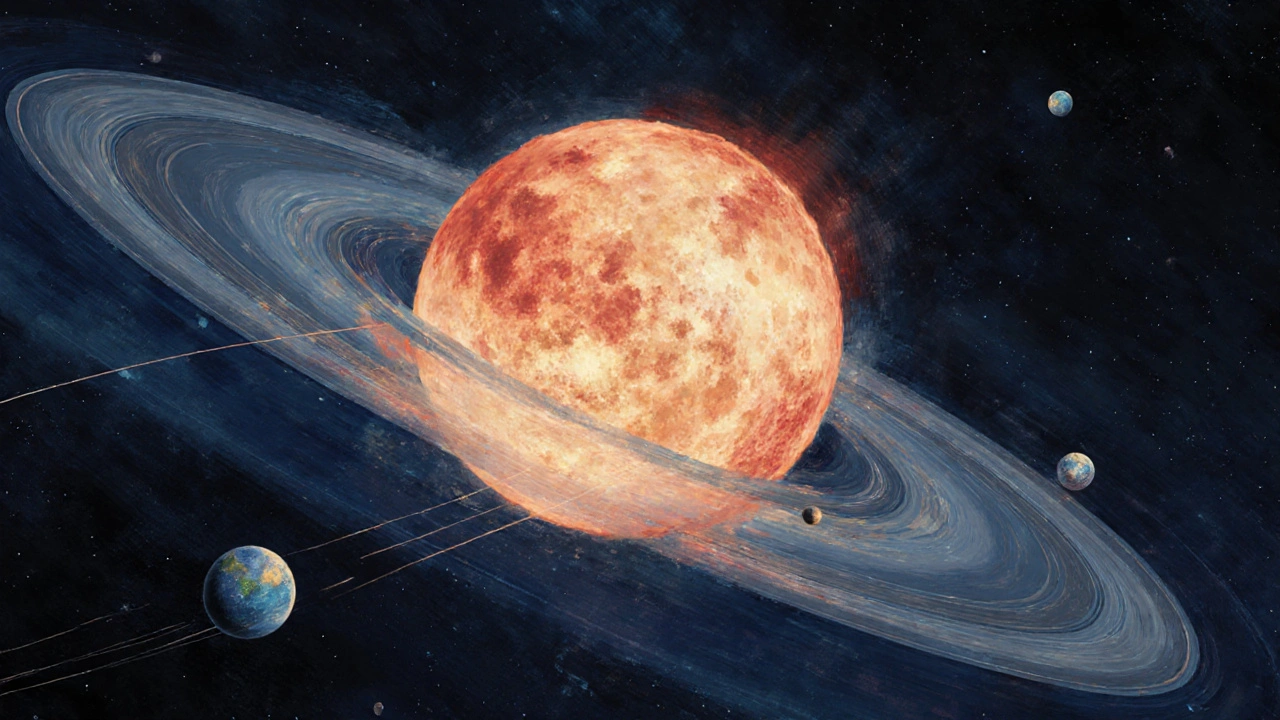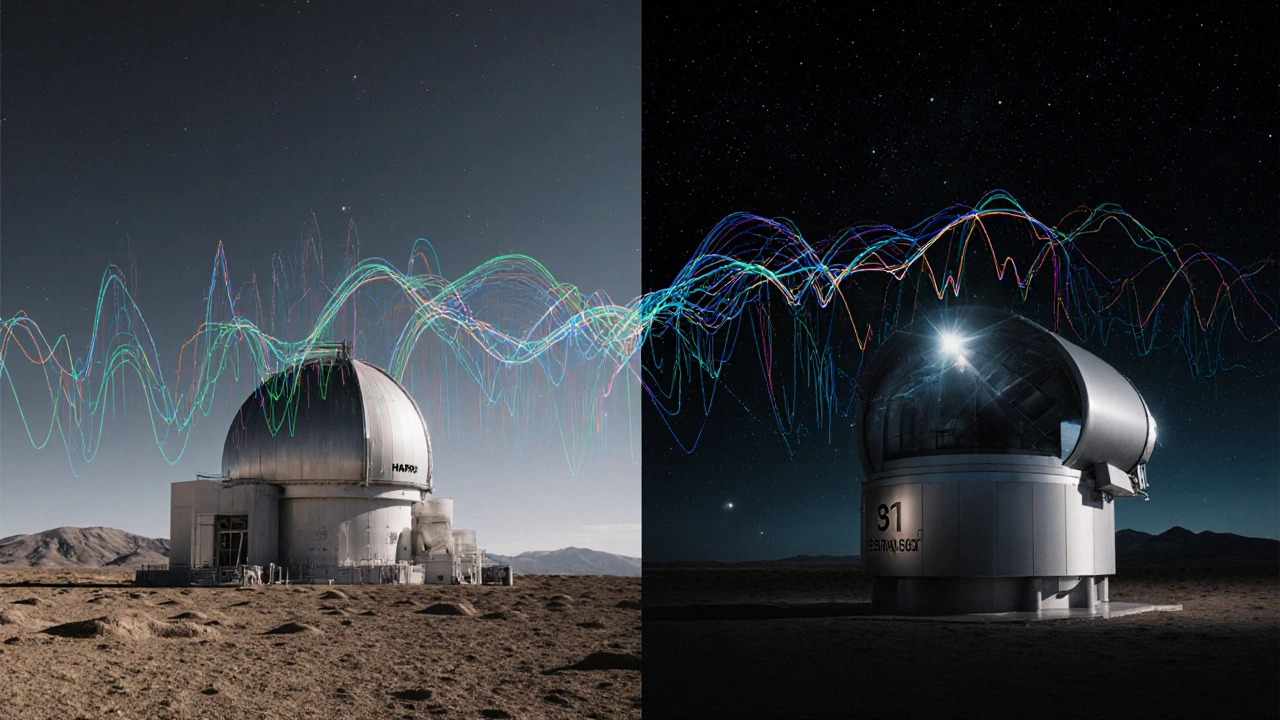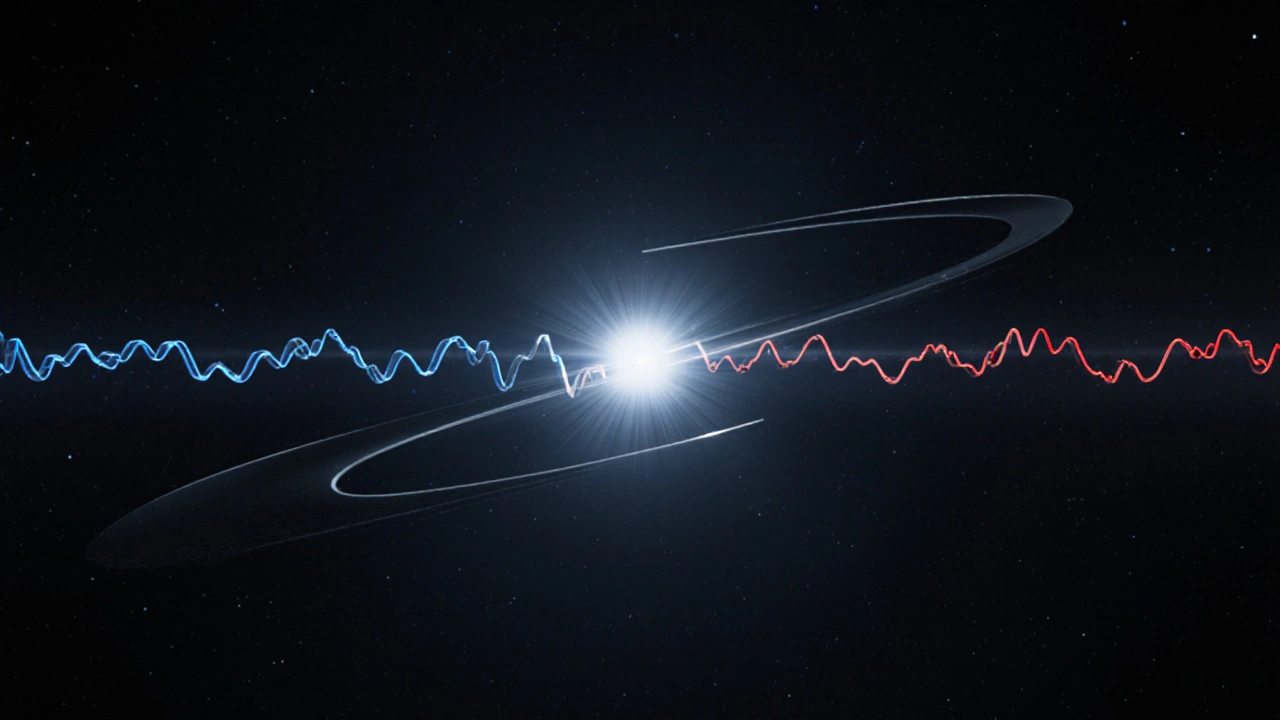When you think of finding planets around other stars, you might imagine telescopes snapping pictures of distant worlds. But here’s the truth: radial velocity method doesn’t see planets at all. It watches stars. And it’s the reason we know about planets like Proxima Centauri b - the closest exoplanet to Earth - and the seven worlds in the TRAPPIST-1 system. This method doesn’t rely on light from the planet. It listens for the star’s whisper.
How a Star Tells You a Planet Is There
Stars don’t sit still when planets orbit them. Even though a star is thousands of times more massive than its planets, both objects actually spin around a shared center of gravity. That center is usually deep inside the star, but not exactly at its middle. So the star doesn’t just sit there - it wobbles. Tiny, slow, almost invisible wobbles. But those wobbles change the star’s motion toward and away from us. And that’s where the Doppler effect comes in. When a star moves toward Earth, its light gets squeezed into shorter wavelengths - it shifts toward blue. When it moves away, the light stretches out, shifting toward red. These shifts are tiny - a few meters per second, sometimes less than a walking pace. But modern spectrographs like ESPRESSO and HARPS can measure them. That’s the radial velocity method: tracking those color shifts over time to find a repeating pattern. That pattern? A planet’s orbit.The First Big Win: 51 Pegasi b
Before 1995, no one knew for sure if planets existed beyond our solar system. Then, Swiss astronomers Michel Mayor and Didier Queloz turned their telescope toward 51 Pegasi, a Sun-like star 50 light-years away. What they found shocked everyone: a planet the size of Jupiter, but orbiting its star in just four days. It was a hot Jupiter - something no theory had predicted. That discovery didn’t just add a new planet. It rewrote the rules. It proved planets could exist in wildly different places than we imagined. And it was all done with the radial velocity method. That moment, in October 1995, kicked off the modern era of exoplanet hunting. Today, over 1,100 confirmed exoplanets have been found using this technique - about 19% of all known exoplanets. Most of them are gas giants. Why? Because big planets tug harder on their stars. And planets that orbit close in make the wobble repeat faster, making them easier to catch.Why It’s Still Important - Even When We Can’t See the Planet
The transit method, which looks for dips in starlight as a planet passes in front, gets all the headlines. NASA’s Kepler and TESS missions have found thousands that way. But transit only works if the planet’s orbit is perfectly aligned with our line of sight. Most aren’t. That’s where radial velocity shines. It doesn’t care about alignment. It detects planets whether they cross the star or not. It also gives us something transit can’t: mass. Transit tells you the planet’s size. Radial velocity tells you its mass. Put them together - and you get density. Density tells you if a planet is rocky, gassy, or something weird in between. That’s how we know TRAPPIST-1’s planets are likely rocky worlds, not gas balls. That’s how we know Proxima b is at least 1.17 times Earth’s mass. And it doesn’t stop there. Radial velocity measures eccentricity - how stretched out an orbit is. A circular orbit? Probably stable. A highly elliptical one? Maybe chaotic. That tells us about the planet’s history and whether it could hold onto an atmosphere.
The Catch: What It Can’t Do
This method isn’t magic. It has limits. First, it only gives you the minimum mass - M sin(i). That’s because we don’t know the planet’s orbital tilt (i) from Earth. If the orbit is edge-on, sin(i) is 1, and the mass we measure is the real mass. If it’s face-on, sin(i) is near zero, and the planet could be way heavier than we think. That’s why Tau Boötis b, detected in 1996, didn’t get its true mass until 2012 - when scientists used infrared light to spot carbon monoxide in its atmosphere and finally pin down the tilt. Second, it struggles with small planets around big stars. An Earth-sized planet tugging on a Sun-like star creates a signal of about 9 cm/s. That’s less than the speed of a crawling baby. Current instruments can barely reach 1 m/s. ESPRESSO is getting close to 10 cm/s - and by 2026, it might hit 1 cm/s. That’s promising. But for now, radial velocity is best at spotting Jupiter-sized worlds or super-Earths around small red dwarfs. Third, stars are messy. Spots, flares, and magnetic cycles can mimic a planet’s signal. A 2022 study found that up to 35% of early radial velocity ‘detections’ around active stars turned out to be stellar noise. That’s why teams now monitor activity markers like calcium lines - to tell the difference between a planet and a sunspot.How It Works in Practice
Finding a planet this way isn’t a one-night job. It takes patience. A typical campaign needs 50 to 100 precise measurements spread over months or years - enough to catch at least one full orbit. For a planet with a 30-day orbit, you need data over several months. For one like Jupiter (12-year orbit), you’re looking at decades. The data doesn’t come from one telescope. It’s built over time, from multiple observatories. HARPS, at ESO’s La Silla Observatory in Chile, has been the workhorse of radial velocity. It’s responsible for about 40% of all detections. ESPRESSO, its newer, more precise cousin on the Very Large Telescope, is now taking over. Both are in Europe - which runs 65% of the world’s radial velocity instruments. North America trails behind with 25%, and Asia with 10%. Once the data is collected, it goes into models. Not simple ones. Researchers use Bayesian Kepler periodograms - complex algorithms that sift through noise to find the most likely planetary signal. It’s like listening for a single voice in a crowded room, using math to pick it out.
Why It’s Still the Best Partner for Transit
Radial velocity isn’t the star of discovery anymore. But it’s the silent partner that makes discoveries meaningful. When TESS spots a candidate planet transiting a star, the next step? Radial velocity follow-up. NASA allocates 30% of its ground-based telescope time to this exact task. Why? Because without radial velocity, you don’t know if that dip in light is a planet - or a star spot, a binary star, or noise. Radial velocity confirms it’s real. Then, you combine the transit size with the radial velocity mass to calculate density. That’s how you know if a planet is a rocky world, a mini-Neptune, or a puffy gas ball. Take TRAPPIST-1. Transit found seven planets. Radial velocity gave us their masses. Together, we learned they’re mostly rocky, with some water content. Without radial velocity, they’d just be shadows in starlight.What’s Next?
The future of radial velocity isn’t about finding more hot Jupiters. It’s about finding Earth twins. ESPRESSO’s upgrade to 1 cm/s precision by 2026 could finally detect the tiny tugs of planets like Earth around Sun-like stars. That’s the holy grail. But it’s not just about better instruments. It’s about better models - smarter ways to filter out stellar noise. Meanwhile, new direct imaging techniques are rising. They’ll take pictures of planets directly, not just guess from wobbles. But those need huge telescopes and dark skies. Radial velocity? It works with existing telescopes, even small ones. It’s cheap, reliable, and stubbornly useful.What You Can Learn From This
The radial velocity method reminds us that science doesn’t always need to see things to know they’re there. Sometimes, you just need to watch how something else moves. A star’s wobble is the fingerprint of an invisible world. And for nearly 30 years, it’s been the most powerful tool we’ve had to count those worlds. You won’t see it in pop science videos. But every time you hear about a rocky planet in the habitable zone, there’s a good chance radial velocity helped confirm it. It’s not flashy. It’s not glamorous. But without it, we’d be blind to half the planets in our galaxy.How does the radial velocity method detect planets?
It detects planets by measuring tiny shifts in a star’s light caused by its motion toward and away from Earth. As a planet orbits, it tugs the star, making it wobble. When the star moves toward us, its light blueshifts; when it moves away, it redshifts. High-precision spectrographs measure these shifts over time to reveal the presence and orbit of an unseen planet.
Why is it called the 'wobble method'?
It’s called the wobble method because the star doesn’t stay still - it moves slightly in a small orbit around the system’s center of mass. This motion, caused by the gravitational pull of an orbiting planet, looks like a slow, rhythmic wobble. Even though the star is much heavier, the planet’s gravity still makes it move, just enough to be detected.
Can the radial velocity method find Earth-like planets?
Currently, it’s very hard. Earth-sized planets only cause a star to move at about 9 cm/s - slower than a crawling baby. Most instruments can’t detect that yet. But next-generation spectrographs like ESPRESSO are being upgraded to reach 1 cm/s precision by 2026. That could finally allow us to detect true Earth analogs around Sun-like stars - if we can filter out stellar noise.
Why does radial velocity only give minimum mass?
The method measures the star’s motion along our line of sight. But we don’t know the planet’s orbital tilt relative to Earth. The true mass depends on that tilt - if the orbit is face-on, the planet could be much heavier than it looks. The number we get is M sin(i), where i is the tilt angle. Without knowing i, we can’t get the real mass - unless we use other methods, like direct imaging or atmospheric analysis.
How does radial velocity compare to the transit method?
Transit finds planets by spotting dips in starlight when a planet passes in front. It’s great for finding lots of planets quickly, but only if the orbit is edge-on. Radial velocity finds planets regardless of orientation and gives their mass. Transit gives size; radial velocity gives mass. Together, they tell us density - and whether a planet is rocky or gassy. Most confirmed exoplanets were found by transit, but radial velocity is essential to confirm and characterize them.
What are the biggest limitations of the radial velocity method?
It can’t detect planets with orbits perfectly aligned to our view (where the wobble is sideways, not toward us). It struggles with small planets around Sun-like stars because the signal is too weak. Stellar activity like spots and flares can mimic planetary signals - up to 35% of early detections were later proven false. It also requires many observations over long periods, making it slow and resource-heavy.
Which instruments are most important for radial velocity discoveries?
The HARPS spectrograph at ESO’s La Silla Observatory in Chile has discovered nearly 40% of all radial velocity exoplanets. Its successor, ESPRESSO, on the Very Large Telescope, is now the most precise instrument in the world, capable of measuring star motions down to 10 cm/s. Both are European-built. Other key instruments include HIRES at Keck Observatory and the upcoming NEID instrument in the U.S.
Is the radial velocity method still used today?
Yes - and it’s more important than ever. While transit methods find most new planets, radial velocity is the go-to tool for confirming them and measuring their mass. NASA allocates 30% of its ground-based telescope time to radial velocity follow-up. It’s the only way to turn a transit candidate into a confirmed, characterizable world. Without it, we’d have a catalog of shadows - not real planets.


10 Responses
Star wobbles are wild. We're basically listening to the universe whisper secrets with light. No fancy pictures needed.
So let me get this straight. We spend billions to detect a planet by watching a star shake like it's having a seizure? And we call this science? Meanwhile, my cat knocks over a coffee mug and we call it chaos. Which one's more reliable?
This is all fake. The government doesn't want you to know stars don't wobble. They're just flickering because the aliens are testing their cloaking devices. HARPS? More like HARP-SPY. They're using spectrographs to mask the truth.
I love how this method is so quietly essential. It doesn't get the flashy headlines, but it's the backbone of so many discoveries. The fact that we can measure motion so tiny it's slower than a baby crawling? That's human ingenuity at its finest. Keep going, science.
I wonder if we'll ever figure out the tilt angle for every planet or if some will always be mysteries. It's kind of beautiful that some things stay just out of reach. Maybe that's how the universe keeps us humble
Honestly, this is the most underrated technique. Transit gets all the attention, but radial velocity is the one that tells you if it's rock or gas. That's the difference between 'maybe habitable' and 'definitely not'. If you're into real planet science, this is where it's at.
Minor correction: it's not just about mass and size. The eccentricity data is huge. A circular orbit means stable climate potential. Elliptical? You're basically playing interplanetary roulette. That’s why we can’t just assume every rocky planet is Earth 2.0.
Europe has 65% of the instruments? That's absurd. The U.S. should be leading this. We built the Hubble, we sent probes to Pluto, and now we're letting Switzerland and Chile dominate exoplanet science? This is a national security issue.
The entire radial velocity method is built on assumptions about stellar behavior that have been repeatedly invalidated. The Bayesian models are overfitted noise filters masquerading as truth. And yet, we treat these detections as gospel. The real discovery here is how easily the scientific community accepts statistical artifacts as facts.
Nathan you’re overthinking it. The method works. We’ve confirmed planets with multiple techniques. If it were all noise, we wouldn’t have consistent results across observatories.